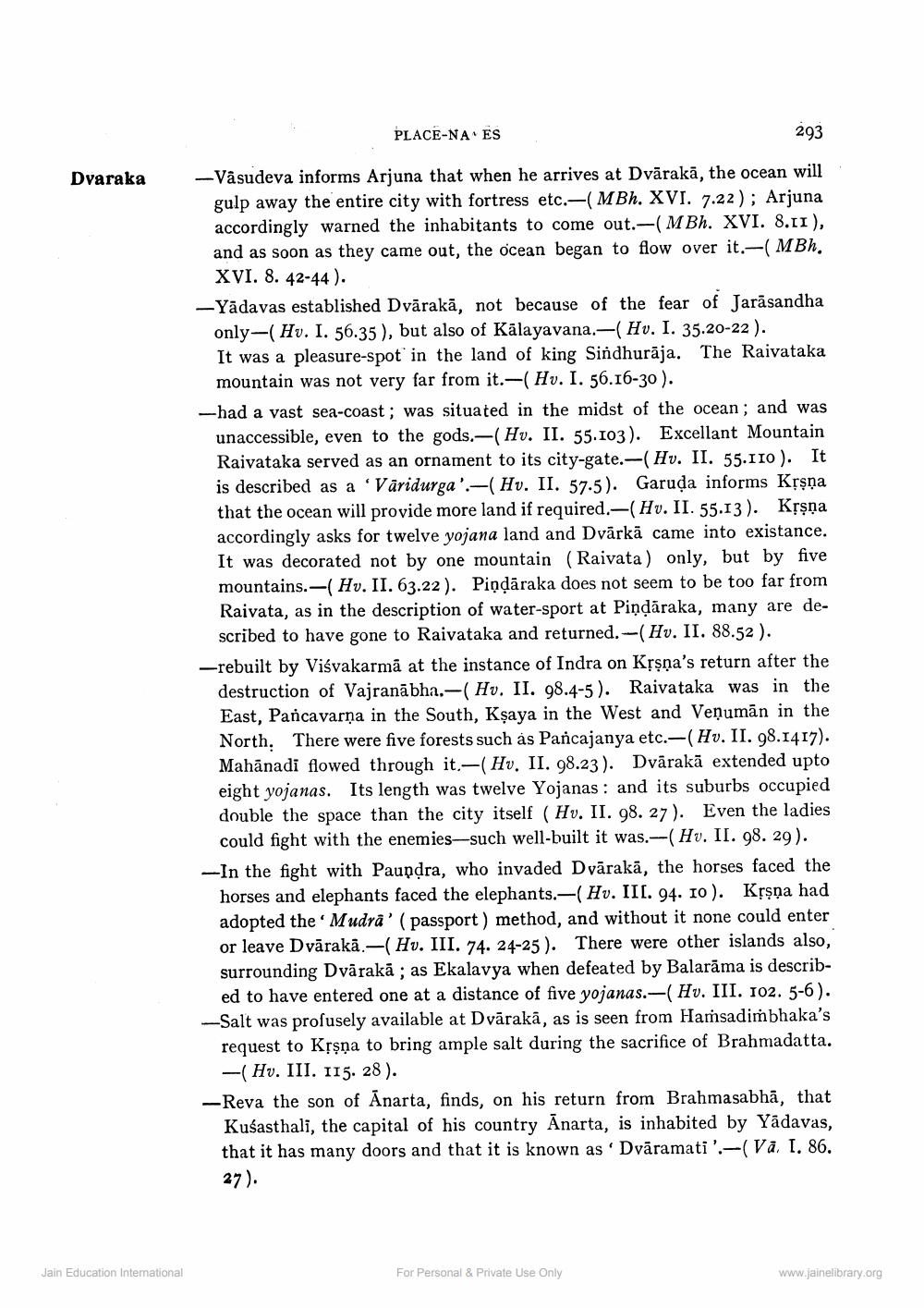________________
PLACE-NA ES
293
Dvaraka
-Vasudeva informs Arjuna that when he arrives at Dvärakā, the ocean will gulp away the entire city with fortress etc.-(MBh. XVI. 7.22); Arjuna accordingly warned the inhabitants to come out.-(MBh. XVI. 8.11 ), and as soon as they came out, the ocean began to flow over it.-( MBh. XVI. 8. 42-44). -Yadavas established Dvārakā, not because of the fear of Jarasandha only-(Hv. I. 56.35), but also of Kālayavana.-(Hv. I. 35.20-22). It was a pleasure-spot in the land of king Sindhurāja. The Raivataka mountain was not very far from it.-(Hv. I. 56.16-30). -had a vast sea-coast; was situated in the midst of the ocean; and was
unaccessible, even to the gods.-(Hv. II. 55.103). Excellant Mountain Raivataka served as an ornament to its city-gate.-(Hv. II. 55.110 ). It is described as a 'Vāridurga':-( Hv. II. 57.5). Garuda informs Kțşņa that the ocean will provide more land if required.-(Hv. II. 55.13). Kļşņa accordingly asks for twelve yojana land and Dvārkā came into existance. It was decorated not by one mountain (Raivata) only, but by five mountains.—(Hv. II. 63.22). Piņdāraka does not seem to be too far from Raivata, as in the description of water-sport at Piņdāraka, many are de
scribed to have gone to Raivataka and returned.-(Hv. II. 88.52). -rebuilt by Viśvakarmā at the instance of Indra on Krşņa's return after the destruction of Vajranābha.- Hv. II, 98.4-5). Raivataka was in the East, Pancavarna in the South, Kșaya in the West and Veņumān in the North. There were five forests such as Pancajanya etc.-(Hv. II. 98.1417). Mahānadi flowed through it.—(Hv. II. 98.23). Dvārakā extended upto eight yojanas. Its length was twelve Yojanas: and its suburbs occupied double the space than the city itself (Hv. II. 98. 27). Even the ladies could fight with the enemies—such well-built it was.--(Hv. II. 98. 29). - In the fight with Paundra, who invaded Dvārakā, the horses faced the horses and elephants faced the elephants.-(Hv. III. 94. 10). Kțşņa had adopted the 'Mudra' (passport) method, and without it none could enter or leave Dvārakā.-(Hv. III. 74. 24-25). There were other islands also, surrounding Dvārakā; as Ekalavya when defeated by Balarama is described to have entered one at a distance of five yojanas.-(Hv. III. 102. 5-6). -Salt was profusely available at Dvārakā, as is seen from Hamsadimbhaka's request to Krşņa to bring ample salt during the sacrifice of Brahmadatta.
-(Hv. III. 115. 28). -Reva the son of Anarta, finds, on his return from Brahmasabhā, that
Kuśasthali, the capital of his country Anarta, is inhabited by Yādavas, that it has many doors and that it is known as 'Dväramati':-( Vå. I. 86. 27).
Jain Education International
For Personal & Private Use Only
www.jainelibrary.org




